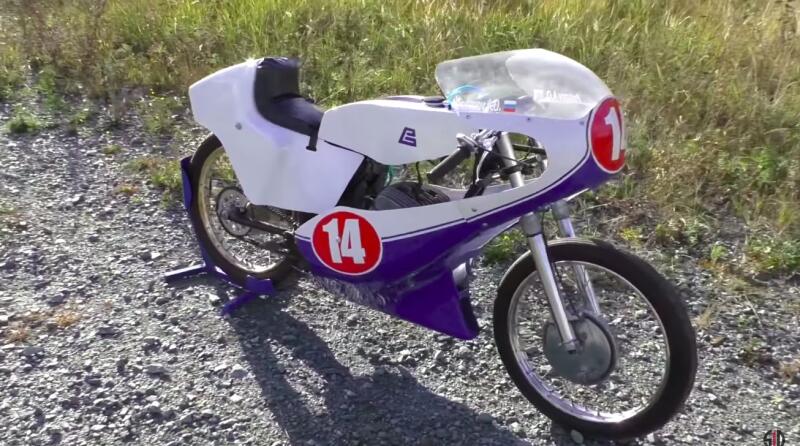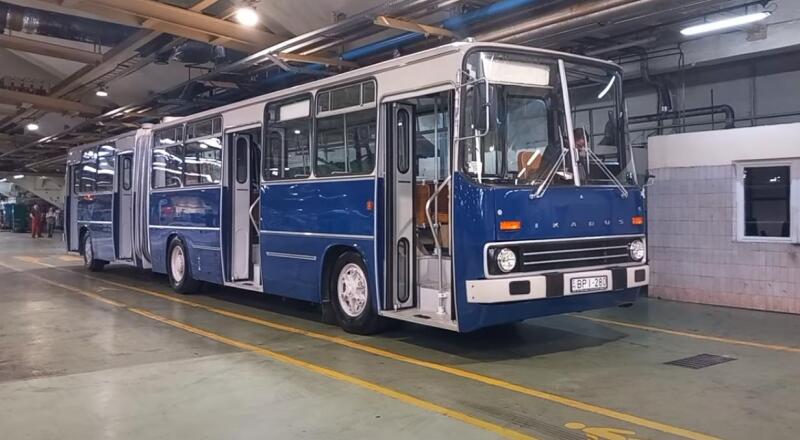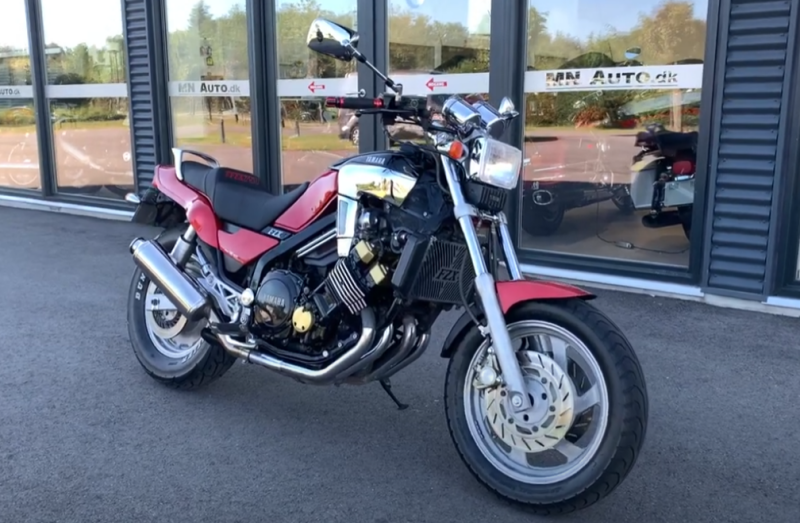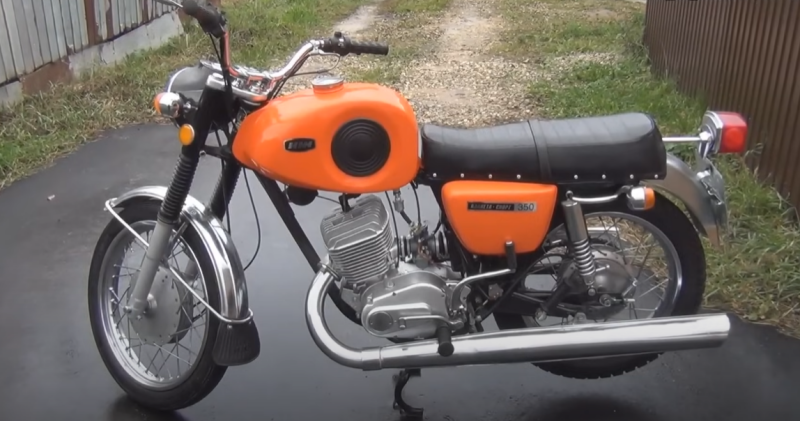For example, in rural areas, heavy equipment was highly valued for its maneuverability. In those days, fuel cost mere pennies, so no one simply paid attention to the amazing gluttony of their 650/750 cc two-stroke engines. As well as the fact that with such parameters they could have significantly higher performance (German BMW can be cited as an example).
 "Voskhod ShK-4", created for cross-country competitions. Photo: youtube.com
"Voskhod ShK-4", created for cross-country competitions. Photo: youtube.comIn the same places, many respected two- or single-cylinder motorcycles of the IZH brand. They were more brutal than the Java, and not as gentle to harsh operating conditions. Sometimes this love was forced, when it was not possible to buy imported equipment, but I wanted a middle-class motorcycle.
On the contrary, lightweight Belarusian devices were considered an excellent option for beginners, retirees, fishing or tourism. Their 125 cc engines have proven to be more than reliable and, in principle, powerful enough for such a small volume.
Not very popular "Sunrises"
It seems we missed another Soviet motorcycle? Yes, there was also a creation of the Kovrov plant, known in stagnant times as “Voskhod”. It was somehow not customary to talk about him in a positive way back then. It so happened that at that time I had not met a single person who would consider himself a fan of the brand (maybe they just had secret admirers). More often than not, these 175cc motorcycles were criticized or disparaged.
 Chain drive "Voskhod ShK-4". Photo: youtube.com
Chain drive "Voskhod ShK-4". Photo: youtube.comMy father, who can easily be considered a home expert, spoke clearly about Kovrov technology. In his younger years, he owned an old Kovrovets, and later two more motorcycles with an updated name (including the black Voskhod-2). He admitted that the first (largely based on the old Cheset) had both reliability and ease of use. But the new ones turned out to be much weaker.
If we add to this my personal experience and impressions, then the Voskhod motorcycles looked much heavier and unruly to drive than the more nimble “Minsk”. Well, compared to IL, they noticeably lost in power and dynamics.
Considering so many unflattering reviews and facts, for some it will be a clear revelation that in Soviet times a whole range of Voskhod brand sports motorcycles were produced. First of all, this number included equipment specially created for cross-country competitions.
The first racing models
But road racing at the international level in the 175 cc class. cm did not exist. Therefore, the equipment produced was intended for the local, intra-Union championship. The first option was Kovrovets-175ShK, which appeared in 1971. It could accelerate to a quite good 125 km/h, producing 14 horsepower.
 1-seater seat. Photo: youtube.com
1-seater seat. Photo: youtube.comThe next one, after changing the brand name, can be considered “Voskhod-175ShK-2” with an engine of the same volume, but with a power increased by two units. This allowed the creators to also add five points to the model’s speed indicators. But for the competing athletes and the DOSAAF society to which they belonged, this was not enough. An official letter was sent to the relevant ministry with a request to create a motorcycle with improved performance.
This is how the modernized Voskhod-175ShK-3 appeared. A little later, the company planned to transition to a more powerful production model with a 250 cc engine. The plans could not be realized, but this contributed to the creation of the cross-country vehicle Voskhod-250ShK-3.
All these developments led to the appearance of the plant’s latest highway-ring model in the early 80s. Some sources indicate 1985 as her official year of birth. Created on the basis of previous types of equipment, the motorcycle was named “Voskhod ShK-4”.
By that time, the design of Kovrov's racing models was very outdated and aroused the same criticism as its production counterparts. Therefore, the plant team made an intensive attempt and carried out homologation in order to maintain competitiveness during the races. The updates affected a number of components and structural elements:
✅ engine characteristics
✅ frame configuration
✅ new fairings
At the same time, many things were carried over unchanged from the “third” model: the braking system, suspension elements and wheel type. The power unit itself was left the same, having undergone additional modifications. True, over time, it was equipped with a cylinder head of a different configuration. Here are some of the technical indicators:
✅ working volume - 175 cubic meters. cm
✅ power - 20 liters. With
✅ maximum speed - 180 km / h
As you can see for yourself, in terms of speed characteristics of the device, everything turned out to be very good. But the situation with his technical side did not look so fun. The basis on which it was created went back to the distant 50s (if not to say to the pre-war DKW). Although superficial modernization was carried out, this was clearly not enough. The motorcycle already at the beginning of its production looked noticeably outdated, which predicted a rather bleak future for it.
Outdated before production
It seems that it became yet another confirmation of the backwardness of the domestic motorcycle industry and the sad gradual decline of the Soviet era. Of course, the plant designers tried to frantically carry out some modernizations, but this certainly did not save the situation.
 Fuel tank with angular shapes. Photo: youtube.com
Fuel tank with angular shapes. Photo: youtube.comEven the external differences of later versions of the Voskhod ShK-4 in the form of fan-shaped fins on the cylinder head (used to improve engine cooling at high speeds) looked only like sad attempts. Of course, they coped with their task, but they could not radically change the situation. But today they have become a very significant difference between motorcycles of later years of production and those assembled in the mid-80s.
Features of technology and completion of release
In addition to the contactless ignition system, the new racing motorcycle received an adapter that makes it possible to install Czech carburetors. It also had an aluminum muffler and a pneumatic damper. There were also external differences from its predecessor:
✅ front wing
✅ footrests of a different shape
✅ new plastic elements
✅ sheet steel fuel tank
The fuel storage had sharp angular shapes, which were considered very fashionable at that time (a clear example of this is the Delta tank). The equipment left the factory without war paint. A pale green (sometimes bright red) tank was adjacent to unpainted plastic elements. The beauty and beauty of the Voskhod-ShK4 was created directly on the spot, by applying numbers and other paraphernalia.
For various reasons, the annual production of the model did not exceed three dozen units. By that time, the door was almost completely open to purchasing a Japanese (or other) alternative with much higher performance. The motorcycle existed in parallel with the Soviet era, disappearing with its end in 1991.
 "Voskhod ShK-4", restored by a collector. Photo: youtube.com
"Voskhod ShK-4", restored by a collector. Photo: youtube.comHowever, decades later, when the fashion for everything Soviet resumed, they remembered the Voskhod ShK-4 motorcycles and rushed to hastily restore the surviving copies. Today he is a welcome guest at exhibitions and museums, always arousing keen interest among the public, as a full-fledged representative of Soviet motorcycle antiquity.










